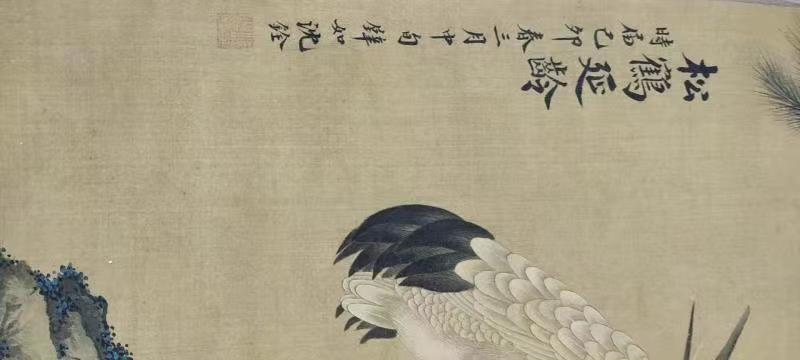In the ninth year of Yongzheng (1731), Shen Quan was hired by the Japanese Emperor, accompanied by his disciples Zheng Pei, Gao Jun, etc. to travel east to Japan, which lasted for 3 years, forming the "Nanping School" sketching, which was highly respected by the Japanese people, known as "the first imported painter", from the study of painters, the Japanese Edo period Nagasaki school was formed under its influence, especially The Most Famous in Maruyama. The gold was scattered to friends and friends, and the bridge was still xiaoran.

After Shen Quan's return to China, his reputation was greatly shaken, and it spread to the capital, and the imperial court ordered Shen Quan to paint a tribute, and Qianlong's 7-year work "The Meaning of The Palace of Lady Huarui" was well received, in addition, Shen Quan also successively painted auspicious allegorical paintings for the court, so Shen Quan and his disciple Tong Heng were known as court painters in the history of Chinese painting, Shen Quan lived in Suzhou in his later years, tirelessly devoted himself to the study of calligraphy and painting art, and Shen Quan, who was 81 years old in Qianlong, could also make "Flower and Bird Diagrams". After Shen Quan's death in 1762, he entered the Nanpin Mansion in Xinshi from his son Shen Tianjun, kept filial piety for three years, inherited the painting industry, and the only disciple who entered the room, Tong Heng, left the Shen mansion to become a monk at the Mingyin Temple in Xinshi, and spent his life painting in spare time. Shen Quan dedicated his life to the cause of painting, and on the basis of inheriting the tradition of the Academy, he created the powerful Nanpin School of Painting, which was unique in Jiangnan at that time, and some poems gave it a high evaluation : "Jiangnan masters who are the first, Wu Xing Shen sheng is unmatched."
His surviving works include: "Deer Group Diagram" and "Crane Group Diagram" with a pair of screens, six pieces each, compiled into the "Catalogue of Chinese Ming and Qing Art Exhibitions", published in 1963 by the National Museum of Tokyo, Japan. The axis of "Songlu Tu", now in Nanjing Museum; the axis of "Songhe Tu", the palace museum, the "Crane Mandarin Duck" axis, in the Nezu Museum of Art, Japan. In 1930, the World Book Company published a photocopy of "Shen Nanping's Feathered Animal Painting Collection"; Japan's Oizuka Qiaoyi Society published a photocopy of "Shen Quan BaixiTu".
The brush strokes of this "Songhe Trilling" are meticulous and neat, the shape is vivid and accurate, the technique is very personal, the pen and ink are exquisite, the color is intense, the attention is rendered, the image is realistic, and the three-dimensional sense is rich. Strong, smooth lines, fine local sketches, and perfect picture composition make it difficult to see that this is the handiwork of an old and rare person. In the picture, the pine trees are vigorous and powerful, and the white cranes under the pine stand tall, which means longevity, longevity and longevity, and high aspirations. The double crane's one leaning up and one leaning, the rhyme is vivid; the song of plum and pine has always reflected the unique personality of things; the red and white of flowers and fruits, echoing up and down; bamboo and thatch between rocks, interspersed with nature, just right, hook flowers and leaves and other painting techniques are flexibly used and developed in sketching, which is both heavy and similar. Judging from the whole work, the river in the painting is gushing and the waves are surging. Above the steep and tall cliffs stood two cranes, their white feathers delicately outlined and rendered in detail; one looked back into the distance, and the other shouted loudly, as if staring at the companions who flew by in the distant sky. The shape of the two cranes is concise and accurate, like the Immortals of the Tao, the appearance is clear, serene, without a trace of tackiness, and the feet and beak of the crane are very realistic. A pine next to it resembles a dragon, and the mottled trunk seems to have experienced countless disasters, showing the distance and vastness of the years. The green bamboo branches between the stone crevices grow luxuriantly, fluttering against the billowing river water, which is a special taste. The work not only fully demonstrates the author's ability to sketch, but also sublimates the realistic painting style of Huang Xiao of the Northern Song Dynasty and Lü Ji of the Ming Dynasty to a new height. Extremely valuable for collection!
In traditional Chinese painting, subjects such as "Songling Crane Shou" are popular with many painters, but how to make works popular and not vulgar is the key to measuring the learning and skills of a painter. Although the theme of Shen Quan's "Songhe Trilling" is ordinary, the connotation expressed between pen and ink is extraordinary. Realistic works first focus on the accuracy of modeling, but they are not simple imitations of natural scenery that remain unchanged, but the re-creation of art.